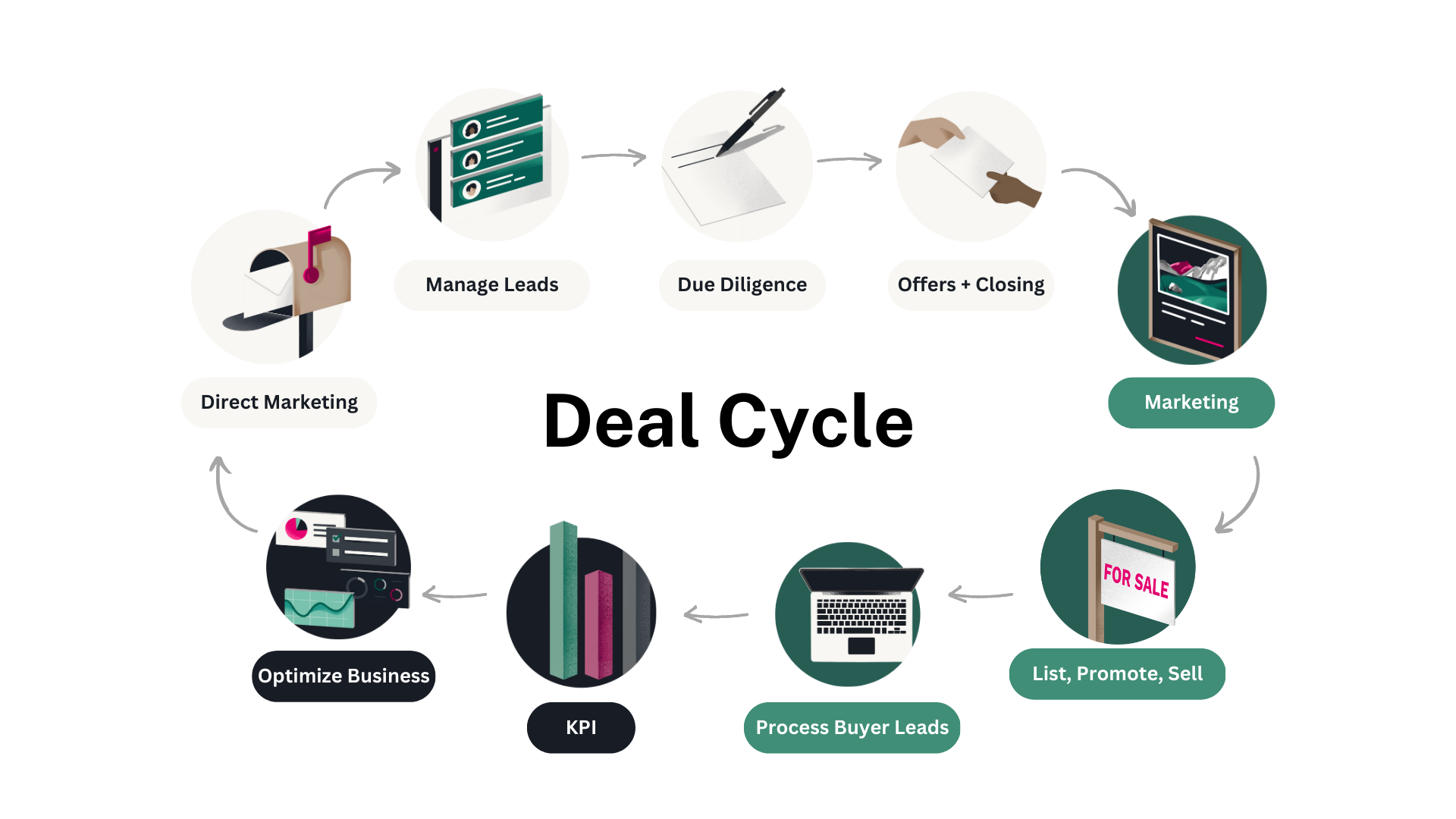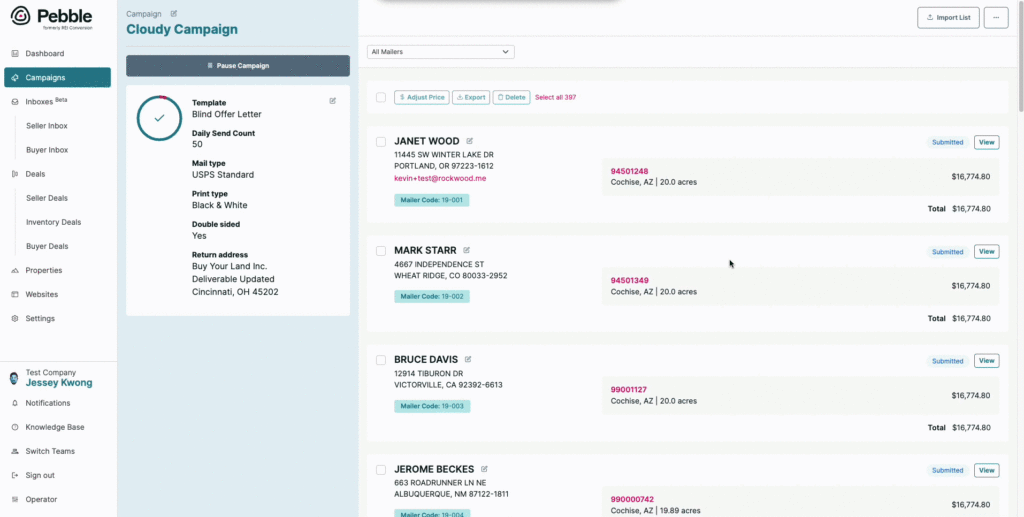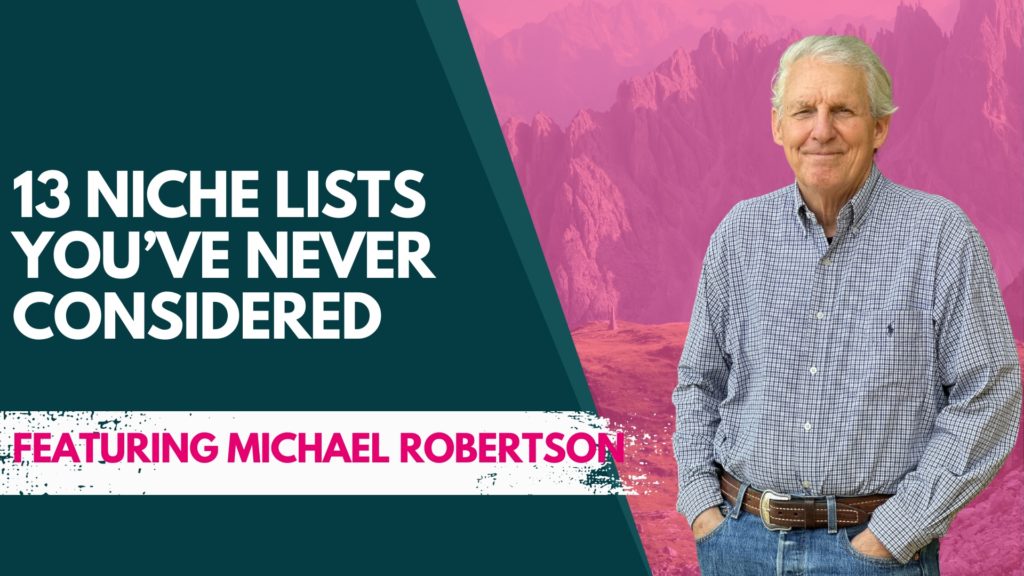
07 Mar 2023
The A to Z Land Investing Workflow
So, you’re a land investor.
Welcome to the (steadily growing) club!
What was once the frontier of real estate investment is slowly but surely being discovered more and more by the day.
Don’t sweat it though, despite increasing competitiveness, flipping land is still far from widespread adoption so the getting is still very good. Particularly if you understand the fundamentals of the land investing process and happen to have a proven workflow to follow.
That’s exactly what we’ll take you through here, the basic framework for buying and selling land from start to finish.
Important! Make Sure to Get Organized!
Before getting into the process, first things first; organization.
Although land investing is just a series of straightforward steps, the amount of property data, leads, mail campaigns and more you’ll have to keep track of mean organization is a must.
Without it, you’ll very quickly start to feel buried.
Check out our deep dive into a number of popular organizational tools that’ll allow you to create a proper land investing system.
Now, onto the main event.

The Buying Process
For starters, what we’ll outline here is the most common roadmap for buying vacant land. Not every investor operates the same way and some put more emphasis on one part over another but in general, the vast majority of land investors follow the basic framework we’ll go through here. One that flows from buying right into selling.
1. Direct Marketing
Before you can get into marketing, there are a few things you need to do first, namely figure out where you’re going to be investing.
a. Research the Market(s)
Smart investments are well-researched investments and vacant land requires just as much investigation as any other investment strategy.
High ROI isn’t an accident, it’s an intention. One that starts with understanding both the market and your own preferences and boundaries.
In the research phase you’ll want to get concrete info on:
- Which market, or markets, you’re interested in buying in
- What type of land, possible uses and zoning
- Whether it’s a hot or cold market
- The estimated market values of properties using a tool like Prycd
- Your budget (marketing + purchase price)
b. Pull Data and Import Properties
Property data is the fuel that runs the land investing engine.
After narrowing things down via your research, you’ll need to pull detail-rich property lists to move forward. You can either get them from the county itself or with data services like DataTree, PropStream, Prycd, etc.
The lists you pull will include info like owner name, APN, market value estimate, zoning and more. Pertinent stuff without which you just can’t make educated moves – or any moves really.
No matter which source you use for data, you can set parameters to only include properties that meet your criteria.
If you’re using Pebble to organize your land business, you can bring a CSV-formatted list straight into the platform and start building your marketing campaign.
c. Create & Send Direct Mail Marketing Campaign
Land investing is one of the few industries where direct mail is still king…and where a 2% response rate is considered a major win.
Despite how archaic it seems; direct mail is genuinely the preferred method from both a cost and effectiveness perspective.
In Pebble, you can create your campaign straight from the list you just uploaded.

And, because all land investors send out a ton of mail, the mailers themselves can be optimized and improved without guesswork. Split testing, or testing one version of a mailer vs another, gives you clear numbers on what people are responding to – and it’s built right into the Pebble workflow.
Data should be the only thing that determines your decision-making.
Moreover, you control every element of the campaign; the send count, mail and print type as well as having the ability to pause and change campaigns mid-stream.
Without Pebble, you’ll have to add the additional step of finding a direct mail service provider and paying for a subscription with them.
2. Manage Leads
After marketing goes out, something wonderful starts to come in…leads!
But if you don’t have systems in place to capture them, you’re in for a world of frustration. Worse yet, you very well could have some leads fall through the cracks.
Despite the fact that your marketing is going out on paper, leads will come in on everything except paper. That means website forms, email, phone calls and texts.
Setting a loss-proof lead capture machine is therefore mission critical.
With Pebble you’ll have one, unified inbox for all types of communication where you can keep the conversations going.
- Website – a pro website builds immediate trust and confidence in your business. With Pebble you can build your site within the platform (we call the sites “Landleads” for buying and “Landlist” for selling). Just add the link to your mailers and interested parties can fill in the form there with their information. Info that is then brought right into Pebble.
- Email – Another item often included on mailers is your email address. You can integrate that straight into Pebble as well and capture those leads.
- Phone calls – Unless you personally want to field all the calls, something that can be a major time suck, it’s wise to contract with a call answering service. Pro-tip: when using a service like PatLive, create a form that they can fill in so the information they capture is immediately added to Pebble. If you’d rather not use a call answering service, at least set up a custom voicemail so potential sellers can leave their information.
- Texts – In the same way you can integrate your email address, you can also add your phone number to Pebble so any text inquiries will come straight to your inbox.
With all leads flowing to one place, losing a lead becomes all but impossible.
3. Due Diligence
“Trust me” is not enough when money is involved.
Do yourself a favor and dig into the details before you seal the deal. Verify the information in the listing and what the owner says. Look into any additional costs like back taxes, HOA fees, etc.
Figure out the cost associated with holding the land for whatever duration you intend to (and give yourself a cushion in case there are hiccups on the sell side).
4. Offers + Closing
When and how you make your actual offer depends on your strategy.
For some, an immediate blind offer sent in the initial mailer is the way to go. You’d do that back step 3.
For others, a more delicate approach like the neutral letter, or withholding your offer until after you’ve started communicating with the owner makes more sense.
Sidenote, you can generate an offer letter and more with Pebble.
Check out our guide to blind, neutral and ranged offers.
a. Document Generation
Once everything looks good, you can draft up the documents you need to close.
Again, something you can do right within Pebble. Sensing a theme here?
From our template library you’ll be able to create:
- Offer letters
- Purchase agreements
- Neighbor letters
- Land contracts
- Deeds
- Thank you cards
Each template is fully editable.
b. Closing
The finish line is in sight now.
With a signed purchase agreement in hand (not required but does show intent), the standard way to close the deal is to hire a title agency or real estate attorney to handle the intricacies and paperwork.
But there are acquisitions where doing it yourself makes sense, namely if the value of the property is fairly low which would make bringing in an agency or attorney cost prohibitive.
In other words, if you’re flipping land with nearly no profit margin, it’s advantageous to do the close on your own. Just make sure you fully understand the process and know which documents are required as each deal and each county has its own nuances.
The best way to understand that process?
Use a title agency on your first few deals even if margins are super slim.
Additionally, you’ll need to figure out if you’ll be buying the land in one payment or financing it if the seller allows for that (financing is the seller’s personal choice as banks don’t generally offer loans for land).
5. Marketing
Getting your marketing right matters.
While there’s no exact science for making the sale since so many factors go into it – location, access and zoning, marketing, etc. – there are things that can improve your chances; mainly, nailing the marketing.
This can be stated strongly enough, the quality of your eventual listing plays a big role.
Before you list, you’ll want to get some killer imagery, think of the wow factor a drone image would give, and put copy together that goes in-depth on the property details to alleviate as many objections as possible.
Of course you can hire an agency to do this whole process for you but keep in mind that can eat into your profits significantly.
6. List, Promote, Sell
You can’t make a sale without putting the land on the market and once you do, you’ll want to shout from the proverbial rooftops that you’ve got a sizzling piece of land that’s not to be missed.
Really, don’t be shy about promotion, the longer you hold vacant land, the more costs you’re likely to incur.
Here are some ways to get the word out:
- Post ads for your listing in the places your prospective buyers might be spending time (i.e., Facebook groups, Zillow, Craigslist, etc.)
- Get in touch with people who own land in the same area and see if they’re interested
- Make an eye-catching and informative Landlist site on Pebble
Note that your list price is also vital for making your desired margins and it speaks to the importance of ensuring you buy the land for a good price to begin with.
7. Process Buyer Leads
Just as it happens when you want to buy land, once you put feelers out for selling, you’ll start to have interested parties get in touch.
Processing seller leads looks very much the same as processing buyer leads and, fortunately, you already have the infrastructure set up if you’re using Pebble.
The unified inbox – the one that handled calls, emails, texts and website form submissions from sellers – works just as well for buyer leads.
In order to save time, you’ll want to develop some simple questions for separating out folks that aren’t particularly serious about buying.
If you’re utilizing a call answering service, you’ll want to add those same qualifying questions to the scripts you provide them.
Lastly, keep everyone’s contact information. Even though they weren’t interested this time, the fact that they got in touch with you means you should still consider them a warm lead for next time. In the future, you can use this list as another way to promote your listings.
8. KPI
Before digging into assessing your KPIs, or key performance indicators, there’s one last step:
a. Closing!
This will be similar to how you closed your purchase, except now you’re on the other side of the equation.
Once you’ve got your closing date on the calendar, the main difference here is who ends up responsible for covering closing costs, which is something you can handle on a case-by-case basis.
The simplest way to close and get paid is to work with a title agency but, again, that’s largely dependent on the price of the purchase and whether hiring someone eats too much of your margin.
Here’s where you can consider offering a financing option. This comes with some risk as you’re doing this on a personal level but the reward is you can make the terms very advantageous while creating consistent cash flow and often make sales quicker.
b. Key Performance Indicators
Now, KPIs. Whether you’ve just closed a deal or not, making a point of regularly checking your progress against your KPIs is important for improving your land business.
For starters, that means you need to set some key performance indicators to track. That can be things like response rate (a must really), profit margins, return on investment or anything else that’s important for you to optimize.
If, for example, you see that your text campaigns are getting more traction and responses than mailers, you can switch the order in which you go about those and add more emphasis to SMS marketing.
This is really about reviewing what has done well for you on the technical side and doubling down on those efforts while at the same time trimming back what hasn’t.
That’s it, that’s all – now repeat

That’s the whole shebang of land flipping.
It may seem like a lot and the first few deals might frustrate you to no end but stick with it.
There’s nothing sweeter than when this all starts to click and the process feels like it flows naturally and the friction fades between steps.

Now that you know the entire workflow from start to finish, systemizing the processes will really get things moving for you. Our Dirt Hacker Challenge helps you do just that in 5 days – without any fancy tech needed. Check it out.
Discover our latest podcast episodes

18 Jul 2024
13 Niche Lists You’ve Never Considered
We’ll cut straight to the chase: if you’re sending mailers, this episode is a must. Michael Robertson builds campaigns like no one else in the business and he breaks down exactly how he makes each of the…

04 Jul 2024
The Secrets of Market Selection: From Spray and Pray to Sniping
Sumner Healy is nothing short of a legend and having him back on the show (third time is a charm!) to get into the nitty gritty of his business is a treat for all.
